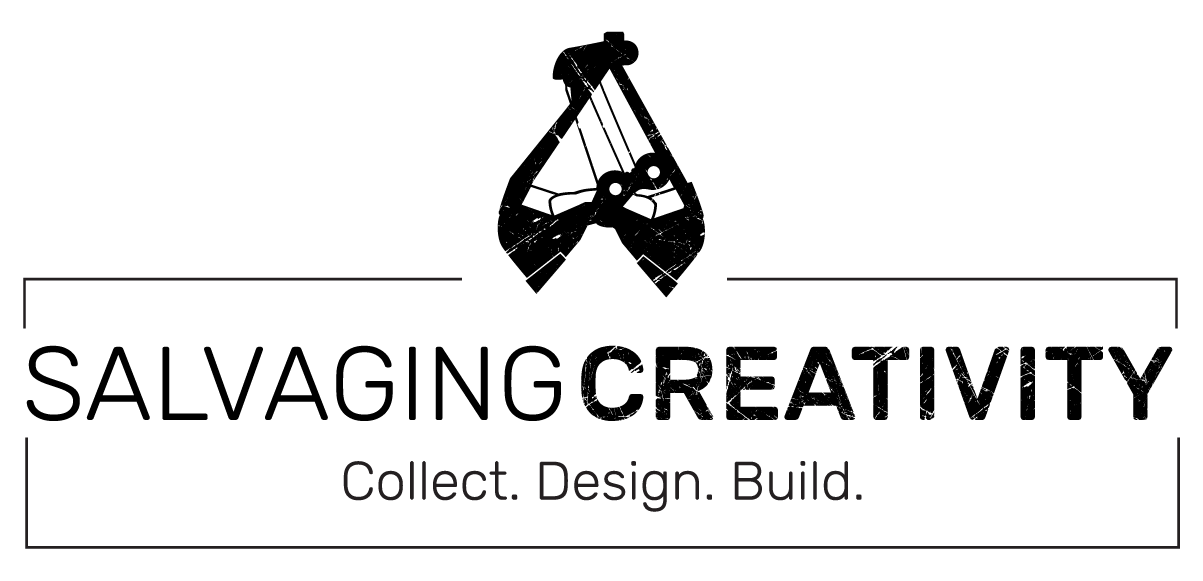BIO
The short story....
After college for engineering and a few years doing structural design for buildings and bridges, Patrick took a side road. The plan was to live out of an old truck exploring North America in search of a creative hands-on life. His father worked for Bethlehem Steel while Patrick grew up in his grandfather’s wood shop. Looking back, it makes sense that he found a beautiful old rust belt factory and started building architectural elements from wood and steel.
Click on each image below for enlarged view. Roll cursor over enlarged image to reveal caption.
Today, Salvaging Creativity is a custom fabrication shop combined with a salvage material warehouse. From our York, PA based shop, we provide design, fabrication and installation services for projects of any scale. Starting with unique salvage material or new stock in metal, stone, timber or glass, we fabricate sculptural lighting, railings, furniture, signage, and outdoor landscape/streetscape elements.
The long story...
The idea for Salvaging Creativity started as an ongoing late night road trip conversation through college between best friends Casey Tyrrell and Patrick Sells in 2003. We have always been most at home exploring and observing the world around us—by ship, bicycle, backpack or road trip vehicle. After graduation, we needed a place to weld and explore our own ideas. We constructed our first 140 sq ft. shop in an abandoned concrete grain silo adjacent to Casey's parent's barn in Whitehall, MD.
At the time, Casey and Patrick worked hands on in the engineering world. Patrick performed structural inspections and prepared rehab plans for highways, bridges, water treatment plants, transportation terminals and waterways. Casey served in the Naval Reserves maintaining the fleet and working as an engineer on 1,000 ft. commercial cargo ships. Patrick spent his days crawling through restricted access spaces while Casey repaired generators, steering gear, and massive 2-3 story diesel power plants on commercial/navy ships. Our careers provided new perspectives on the natural world and an appreciation for human design ingenuity. Commercial ships, freight terminals, abandoned industrial sites, shipyards of the world are the often hidden underbelly of our economy and material culture.
While our society's designers create stylized spaces and surfaces as our public environments, industrial spaces evolve out of necessity and innovation. These spaces tell the material stories of our society's needs and desires. They also leave an imprint of how things were made in the ever evolving landscape of our post industrial economy. Following these experiences, and our aversion to working full time at a desk, we sought to create a livelihood balancing thinking and doing. We saw that satisfaction came from designing and fabricating useful additions to our built environment.
For the next few years, we worked full time in our engineering careers learning and saving money. Every second free of our regular jobs was spent improving our barn/silo workshop and collecting tools. During this period, we were building live/work road trip vehicles to travel cross country and find jobs with groups building unique homes. Before we escaped to the west, we forged a relationship with the Washington, D.C. collaborative Helicon Works and Abrams Design-Build. These east coast firms were producing unique concepts, exploring natural design, energy efficiency and bringing true craft back into home construction. We began designing and fabricating metal elements with Helicon Works and Abrams Design-Build. This was the start of Salvaging Creativity.
In 2007, Casey and Pat came to York, PA seeking a place to live and work that had access to salvage materials, allowed storage of our found objects and in some way fit with this evolving idea of developing a right-scaled manufacturing economy within the bones of past as well as active industry. By some sort of miracle (or curse—depending on the day) we found and purchased 3 abandoned buildings Nos. 48-51 (out of 114) of the York Ice Machinery Corporation (now owned and operated by Johnson Controls Corporation).
This plant began in 1895 when 6 industrial revolution investors joined to develop, fabricate and sell agricultural equipment, hydro power equipment and refrigeration equipment as the York Manufacturing Company. The company evolved to focus on the production of Ice Making/Refrigeration/Air conditioning equipment as the York Ice Machinery Company, then became York International. Buildings 48-51 were constructed sometime around 1922. By 1927, York Ice Machinery had outgrown their original site and constructed a larger more modern plant across town off Grantley Avenue. Today at the Grantley Plant, the Johnson Controls Corporation continues to create modern large scale climate conditioning equipment. The original Industrial Plaza of York site was a major contributor to today's industrial food production (breweries, ice cream, climate controlled food storage) and air conditioning industries. Operating our business in this space helps to inform our work and remind us of our place as craftsman at one spot in the arc of time.
Click on each image below for enlarged view. Roll cursor over enlarged image to reveal caption.
Since 2007, we have been steadily working to bring our original business vision to life.
York City and the surrounding county serves as an ideal location to develop this vision. The community has a rich history of ingenuity and craft that continues strong today. Here we are able to draw upon the resources of many local industries for salvage materials as well as experienced technical fabrication/manufacturing. From Amish cabinetry/furniture makers, plastics/glass/composites manufacturing to high tech electronics, we have access to materials and know-how. Our company is also a short drive to our markets in Washington, D.C., Baltimore, Philadelphia and New York.
As local entrepreneurs and developers, we seek to foster the continued growth of our community through additions to the built environment, the re-purposing of industrial leftovers, encouraging new businesses, and teaching the industrial arts.











